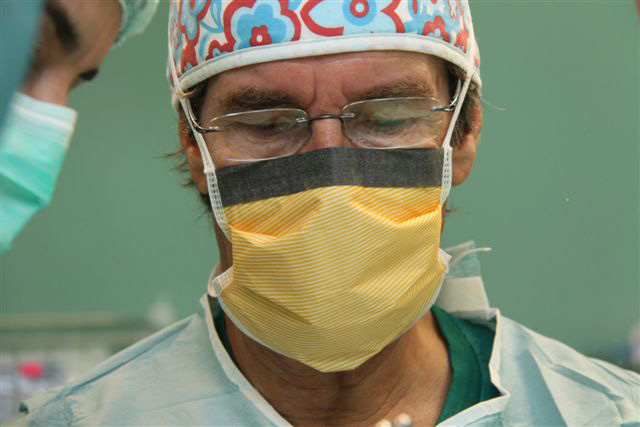Pelvic Floor Surgery
What is called pelvic floor?
The pelvic floor is a group of muscles, ligaments, connective tissue and nerves that allow the support and control of the uterus, vagina, bladder, urethra and rectum.
The pelvic floor can be damaged by dystocia, lift weights regularly, chronic illness or previous surgery.
The loss of vaginal support the pelvic organs often involves pelvic floor dysfunction with consequent functional impairment, depending on the affected compartment.
Many women suffer unnecessarily a series of disturbances that provoke a pelvic relaxation. Proper diagnosis and specific treatment of these disorders allow the patient to regain their quality of life without the hassles associated with this dysfunction
What are its causes?
Childbirth can give rise to a series of pelvic floor disorders with a weakening that can worsen with age and cause pelvic organs not maintain its normal position.
Sometimes the weakness of the muscles and ligament abnormalities can occur in women who have never had children. In these situations can be:
• Changes in collagen
• Congenital weakness of the muscles or supporting tissues
• Exhaustion in the supporting tissues due to chronic cough
• Unusual increases in abdominal pressure
• Obesity
• Menopause, the decrease of estrogen
What are the symptoms of pelvic floor disorders?
Pelvic floor disorders often give the following symptoms:
1. Urinary incontinence: involuntary loss of urine without control of filling and emptying of the bladder, sometimes there is a strong desire to urinate.
2. Loss of control of the retention of feces and exhaust gases.
3. Genital prolapse: descent of the pelvic organs below the normal position into the vagina noticing a “bulge” at the external genitalia and usually accompanied by local disturbances.
4. Pelvic pain, burning or other symptoms such as pain in the bladder or urethra.
5. Alterations and “discomfort” in sex.
What is genital prolapse surgery?
For many years, uterine prolapse surgery performed preferably by vaginal hysterectomy practicing and arranging support structures of the uterus in this way.
Since 1995, anatomical and functional investigations of the pelvic floor and technological advancement of laparoscopy are rapidly changing the treatment of genital prolapse, offering good results with the aim of restoring the normal anatomy of the pelvic floor prolapse and correct if .
There are many types of surgical techniques and depending on the cause of incontinence, the type of pelvic floor disorder, physical condition and health of the patient to combine different procedures.
The suspension and fixation with synthetic mesh by laparoscopy is a procedure performed with the practice of hysterectomy if needed and fixing the vaginal vault to the sacral promontory using a synthetic mesh (polypropylene), in addition to the mesh fixing the levator ani muscles and repair the harmful effects of rectum.
This will correct the abnormal anal incontinence or defecation, urinary incontinence is restores the anatomy secondary to prolapse and sexual function is preserved in order to achieve better quality of life.
Always considered the pelvis as a unit with three compartments (anterior, medial and posterior) for suspension and support elements to work properly, so that no one ever corrected isolated defect.
Everything described is known as laparoscopic reconstructive surgery of advanced pelvic floor. Requires experienced personnel in this field and skill of the surgeon with laparoscopic experience. The aim is that patients with complex problems of the three compartments (bladder, uterus, rectum) are referred to a clinical specialist and / or surgeon who knows the three areas and to deal with a single query and a single physical examination. 20% of patients required combined procedures that can be done in one surgical time.
What are the advantages of laparoscopic surgery?
Vision is achieved with increased and more targeted areas deep in the pelvis with easier access to anatomical spaces with other types of surgery are difficult to address.
Being able to clearly visualize the surgical field, better identify and analyze flaws stand so that the sutures are more accurate and effective than traditional surgery. The correction is perfect anatomical and functional results.
Blood loss during operation is less, reduced postoperative pain with less need for medication, minimal scarring, shorter hospital stays, faster recovery and early resumption of work activity.
What is surgery for urinary incontinence?
There are two paths:
A-vaginal surgery: are the tension-free, TVT, cistorrafia …
This surgery is performed in cases of SUI or mixed in which there is no other disorder associated with pelvic floor disorders only in the anterior compartment. It’s fast, easy, do not require general anesthesia, the recovery is quick and satisfactory results.
Interventions are very grateful even in elderly
B-laparoscopic surgery: when associated with urinary incontinence uterine prolapse, the most widely used technique is called the Burch operation (retropubic colposuspension) and that through laparoscopy can be used while other procedures to restore support normal genital structures such as tension-free mesh colposacropexy.
Open abdominal surgery for urinary incontinence tends to disappear as laparoscopic techniques offer similar results with the advantages of minimally invasive surgery.
When any of these problems is important surgically repaired properly and each of the disorders.

